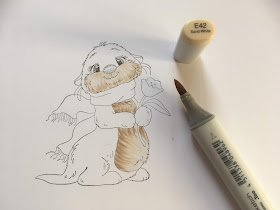Hello everyone,
I really love colouring fur so I thought I would do a tutorial for you!
I am using a stamp by Whimsy Stamps - My Significant Otter and Copic Markers
E40, E41, E42, E43, E44, E51, E53, E55, E57, E59
The technique I have used is very similar to one you would use for colouring hair! Here are a few top tips for you!
It's good to use a flicking motion to apply the ink, this helps add texture.
Always make a flick in one smooth movement.
Always make a flick in one smooth movement.
Always flick in the direction the fur grows.
Let each layer of ink dry before adding the next so the colours don't blend together
I always practise my flicks on a piece of scrap card before I start colouring my image, this gets my hand used to the flicking action - it might sound silly but trust me - it works!
There are a lot of photo's for this tutorial so please be patient!

To begin, I lightly coloured the otter's tummy with E40. This does nt need to be too neat or perfectly blended, it is simply a base layer for the fur to sit on.
Then, I started to add flicks in E42, in the darker parts of the tummy area, some of these need to be quite long and go across the tummy to add texture.
Then add more flicks with E43.
Next I coloured the mask, again with a light layer of E40.
Then, exactly like the tummy, I started adding flicks in E42...
E43
and W3, which adds some depth.
I then moved on to the paw, lightly colouring all of it with E55.
followed by flicks in E57
and E59.
I did exactly the same with the other paw, a light layer of E55
Followed by flicks in E57
and E59.
The same technique is then used for the feet (paws)! E55 coloured all over and followed by flicks in E57
and E59.
Then I moved onto the otter's body. It is a good idea to take this really slowly - do not rush! You can still break the body down into smaller parts, the tail, the foot and the area under the am and tummy. I used exactly the same technique as before, colouring the whole body with E55 and then starting to add colour and texture by flicking with E57
and E59.
To enhance the shaded parts of the body, where I wanted it to look darker, I added a few flicks of E49. If you choose to do this you only need a few - do not add too much of this darker colour!
Next, I moved on to the face and head, colouring the whole area lightly with E55.
Then I added flicks of E57 around the eyes, down the sides of the muzzle and on the top of the head,
Followed by Flicks of E59...
...and W6
You might want to go for a break and a cup of tea here, before you start the colouring the last parts of the image! (:
I coloured the darkest, shaded areas of the scarf in BG32 to map out where my darkest colour would go. It's a good idea to do this first, in a light colour because if you get it slightly wrong at this stage, you can cover it up later, you have n't ruined your colouring by going straight in with your darkest shade!
I then went back and coloured these parts with BG49
and then started blending the colours out to the lightest area with BG13.
I repeated this, colouring the same darkest part again with BG49,
then blending BG49 out with BG13
followed by BG11.
I used exactly the same technique to colour the rest of the scarf.
I coloured the flower next in BG04
followed by BG37,
BG06...
...and BG04.
For the leaves and stalk I used G43,
followed by G46...
G43...
...and finally YG03
I hope you have found this tutorial useful!
It would be great if you could try this technique and share with us on Facebook at
It's our 30th Wedding Anniversary this weekend and this card is for my lovely husband!
Thank you for popping by
Sue...xxx







































Sue this is brilliant! Lucky hubby. What a gorgeous card!! Love it xoxo
ReplyDeleteGorgeous card and a great image used too for your tutorial thank you for sharing this enjoy your weekend x
ReplyDeleteBeautiful colouring and grate tutorial. Thank you and enjoy your weekend 🎈🎉
ReplyDeleteThanks or sharing this wonderful tutorial. I'm attempting this today, Mary G xx
ReplyDelete